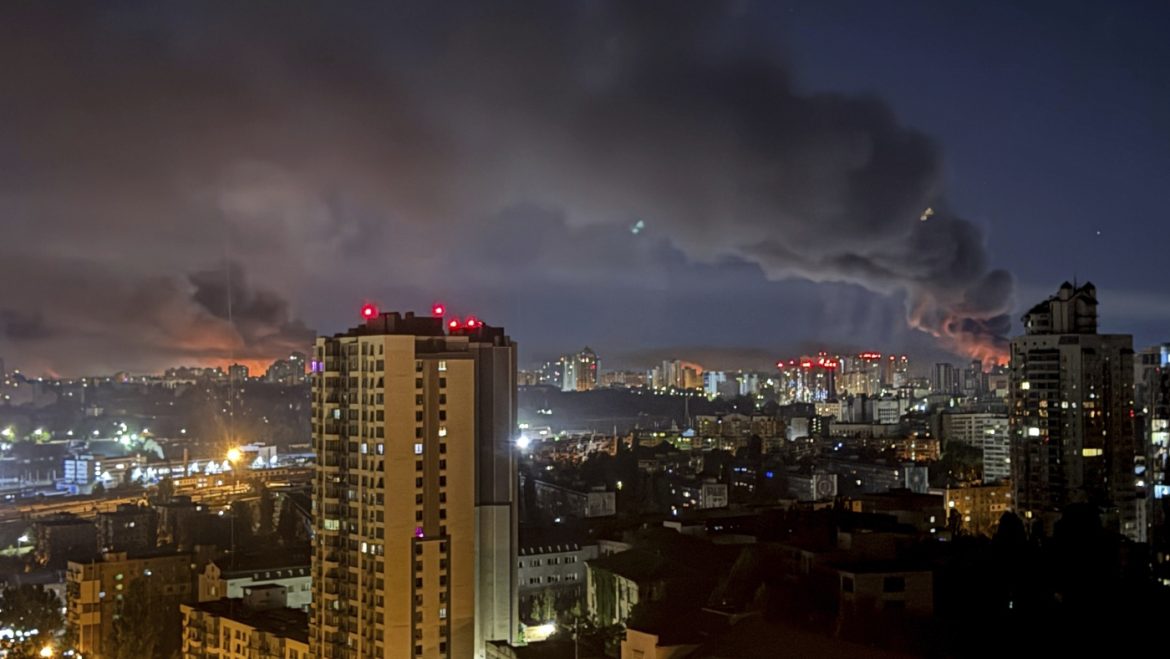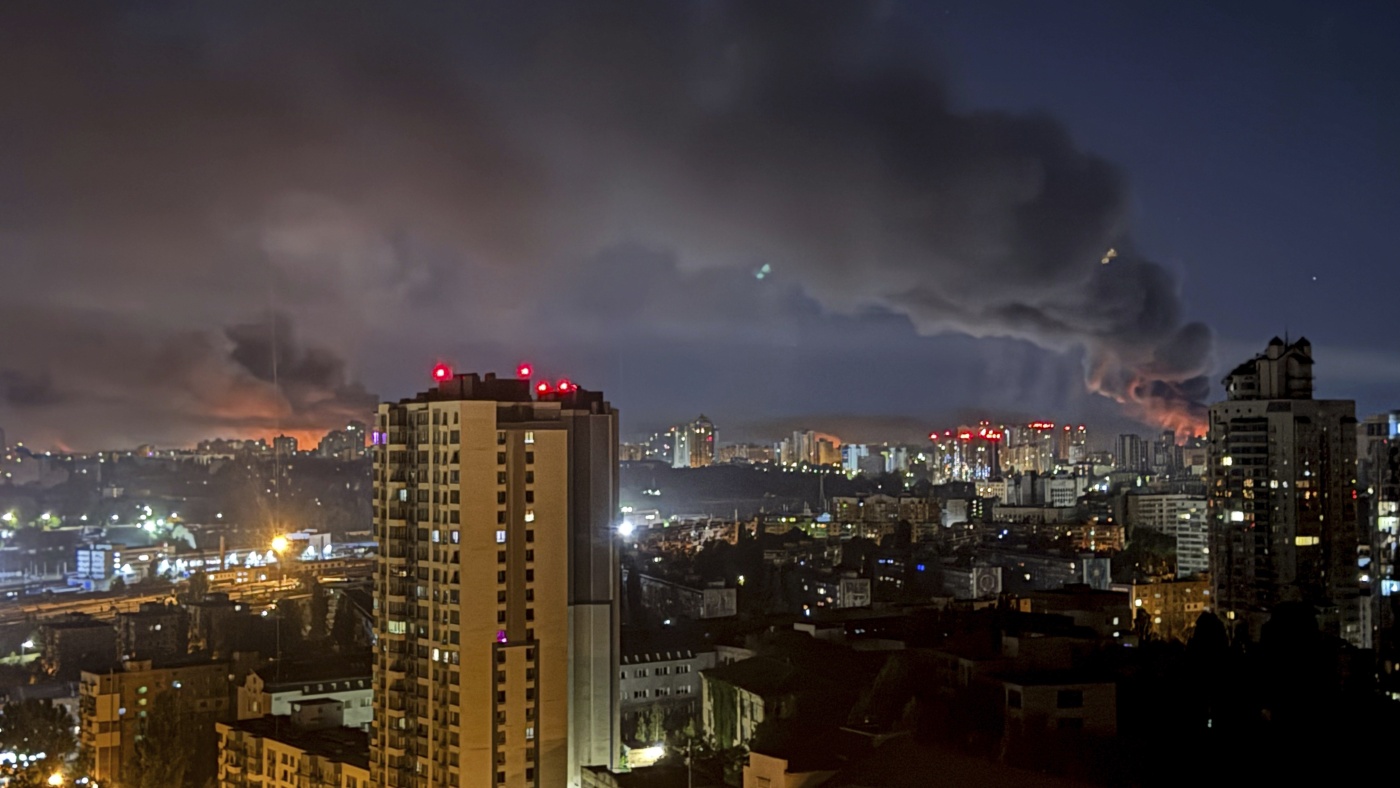The recent escalation of Russian aerial attacks on Ukraine, particularly the massive barrage targeting Kyiv, marks a concerning turn in the ongoing conflict. This surge in aggression arrives at a sensitive juncture, coinciding with renewed engagement between former U.S. President Donald Trump and Russian President Vladimir Putin. The juxtaposition of these events raises critical questions about the potential implications for the war’s trajectory and the broader geopolitical landscape.
A Storm of Steel: The Scale of the Attack
The sheer scale of the recent Russian offensive is staggering. Reports indicate that Russia unleashed a coordinated wave of approximately 550 missiles and drones, overwhelming Ukrainian air defenses. This onslaught, characterized as the largest aerial assault on Kyiv since the war began, underscores Russia’s willingness to employ its full military capabilities. The attacks deliberately targeted civilian areas, resulting in casualties and widespread damage to infrastructure. The Ukrainian Air Force reported shooting down a significant number of incoming projectiles, but the volume of the attack meant that many still reached their targets, highlighting the immense pressure on Ukraine’s defense systems.
The intensity of the attack suggests a strategic shift in Russia’s approach. Historically, Russia has relied on a combination of ground forces and long-range artillery to wear down Ukrainian defenses. However, the recent aerial barrage indicates a new phase in the conflict, one that leverages Russia’s air power to inflict maximum damage on key urban centers. This shift could be a response to Ukraine’s successful counteroffensives in the past, which have demonstrated the country’s resilience and adaptability. By escalating the aerial campaign, Russia aims to disrupt Ukrainian supply lines, demoralize the population, and force Ukraine into a position of vulnerability.
Echoes of the Past: Trump and Putin
The timing of this intensified offensive, occurring shortly after a phone call between Trump and Putin, fuels speculation about a potential shift in the dynamic of the conflict. Trump’s previous stance toward Russia, characterized by a perceived alignment of interests and a reluctance to fully condemn Russian aggression, has long been a source of concern for Ukraine and its allies. While the details of the recent conversation remain undisclosed, the subsequent Russian attack raises questions about whether Trump’s engagement might have emboldened Putin.
Trump’s political influence and his potential return to the White House add another layer of complexity to the situation. His past statements about ending the war quickly, possibly on terms favorable to Russia, have raised alarms among Ukraine’s allies. If Trump’s engagement with Putin is interpreted as a signal of weakened Western resolve, it could encourage further Russian aggression. Conversely, if Trump’s approach is seen as a potential pathway to negotiations, it could provide Putin with leverage in future diplomatic discussions. The ambiguity surrounding Trump’s intentions and the lack of transparency in his communications with Putin create an environment of uncertainty, which Russia may exploit to its advantage.
The Strategic Calculus: Putin’s Objectives
Several factors may be driving Putin’s decision to escalate the conflict at this particular moment.
Demonstration of Power
The massive aerial attack serves as a powerful demonstration of Russia’s military might, both to Ukraine and the international community. It underscores Russia’s unwavering commitment to achieving its objectives in Ukraine, regardless of international pressure. By showcasing its ability to launch large-scale attacks, Russia aims to intimidate Ukraine and its allies, sending a clear message that resistance will be met with overwhelming force.
Weakening Ukrainian Resolve
By targeting Kyiv and other major cities, Russia aims to undermine Ukrainian morale and erode public support for the war effort. The attacks are designed to create a sense of vulnerability and to force Ukraine to divert resources from the front lines to protect its civilian population. If successful, this strategy could weaken Ukraine’s ability to sustain its defense efforts, potentially leading to a shift in the balance of power on the battlefield.
Testing Western Resolve
The timing of the attack, coinciding with Trump’s engagement with Putin, could be interpreted as a test of Western resolve. Putin may be seeking to gauge the extent to which the United States and its allies are willing to continue supporting Ukraine in the face of escalating aggression. If the international community responds with hesitation or divided opinions, it could embolden Russia to further escalate its military actions.
Gaining Leverage
With various reports indicating that the battlefield momentum is favoring Russia, this show of force could be an attempt to gain leverage in any potential future negotiation. By increasing the stakes, Putin might be looking to secure more favorable terms for Russia in any eventual peace settlement. This strategy aligns with Russia’s historical approach to negotiations, where military pressure is often used to extract concessions from adversaries.
The Human Cost: Lives Disrupted
Beyond the strategic and political implications, the human cost of the escalating conflict is devastating. The aerial attacks have resulted in casualties, injuries, and the displacement of countless Ukrainians. Families have been torn apart, homes destroyed, and lives irrevocably altered. The psychological impact of living under the constant threat of bombardment is immense, creating a climate of fear and uncertainty. The attacks serve as a stark reminder of the human suffering that continues to unfold in Ukraine.
The humanitarian crisis in Ukraine is exacerbated by the destruction of critical infrastructure, such as hospitals, schools, and energy facilities. The loss of these essential services compounds the suffering of the civilian population, making it increasingly difficult for Ukrainians to cope with the ongoing conflict. International aid organizations have reported significant challenges in delivering assistance to affected areas, further highlighting the urgent need for a comprehensive and coordinated response from the global community.
A Fork in the Road: Geopolitical Implications
The current situation presents a critical juncture for the international community. The response to Russia’s escalation will have far-reaching consequences for the future of the conflict and the broader geopolitical order.
Strengthening Ukrainian Defenses
The attacks underscore the urgent need to provide Ukraine with the necessary resources to defend itself. This includes air defense systems, ammunition, and other military equipment. Failure to adequately support Ukraine would embolden Russia and further destabilize the region. The international community must prioritize the delivery of advanced weaponry and intelligence support to help Ukraine counter Russia’s aerial superiority.
Maintaining International Unity
It is crucial for the international community to maintain a united front against Russian aggression. This includes imposing sanctions, providing humanitarian assistance to Ukraine, and diplomatically isolating Russia. Any signs of disunity would undermine the efforts to deter further escalation. The European Union and NATO must continue to coordinate their responses, ensuring that Russia faces consistent and coordinated pressure from multiple fronts.
Re-evaluating Diplomatic Strategies
The recent events necessitate a re-evaluation of diplomatic strategies. While dialogue with Russia remains important, it must be conducted with a clear understanding of Putin’s objectives and a firm commitment to upholding international law. Any attempt to appease Russia would only embolden further aggression. Diplomatic efforts should focus on securing a just and lasting peace, one that respects Ukraine’s sovereignty and territorial integrity.
The Spectre of Trump
It is impossible to ignore the potential impact of Trump’s political future on the war. His statements about potentially ending the war quickly, possibly on terms favorable to Russia, create additional uncertainty and add complexity to the situation. The international community must carefully consider the implications of Trump’s engagement with Putin and ensure that any diplomatic efforts are aligned with the broader goals of supporting Ukraine and maintaining global stability.
A Defining Moment: The World’s Response
The aerial attack on Ukraine represents a significant escalation of the conflict and a challenge to the international community. The world’s response to this aggression will determine the future of Ukraine, the credibility of international law, and the stability of the global order. Inaction or appeasement would send a dangerous message to authoritarian regimes around the world, emboldening them to pursue their own expansionist ambitions.
The international community must stand united in its support for Ukraine, providing the necessary resources to defend its sovereignty and protect its people. Only through collective action and unwavering determination can we hope to deter further aggression and pave the way for a just and lasting peace. The stakes are high, and the choices made in the coming months will shape the geopolitical landscape for years to come.


